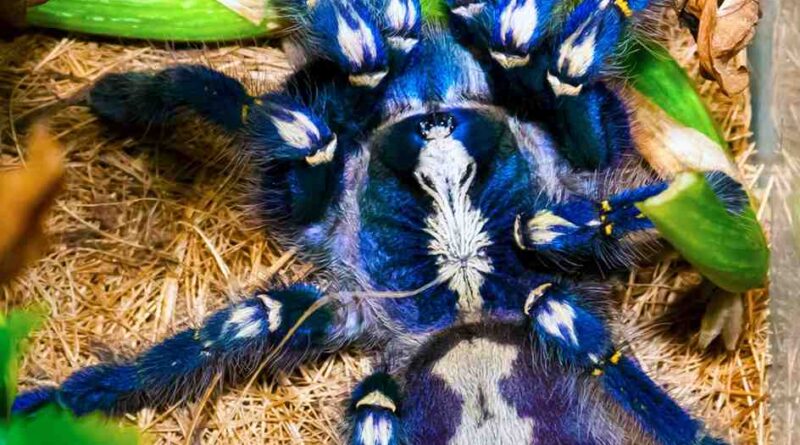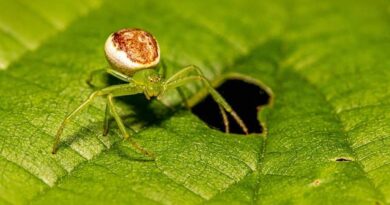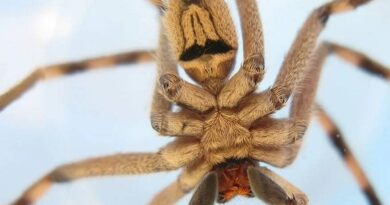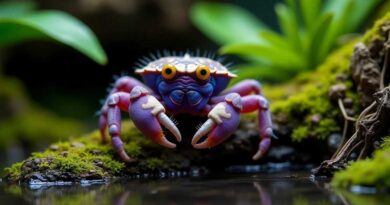Gooty Sapphire Tarantulas: Are They Poisonous?
Are Gooty Sapphire Tarantulas Poisonous? Myths Debunke
The Gooty sapphire tarantula, also known as Poecilotheria metallica, is often surrounded by myths about its venom. While their bites can cause moderate to severe pain, such as muscle cramps, headaches, and nausea, they are not deadly to humans. The species does not have urticating hairs like some other tarantulas, but their bites may result in intense pain and symptoms like swelling, increased heart rate, and cramping. However, Poecilotheria bites are rarely medically significant, and many bites are dry, meaning they inject no venom. The effects, though painful, typically subside after a few days, though in extreme cases, discomfort may last for several months. Tarantula keepers are advised to exercise caution when handling this defensive species.
More In Details about Gooty Sapphire Tarantulas
The Gooty sapphire tarantulas get their name from the place they were originally discovered in Gooty, a town in Andhra Pradesh, India, back in 1897. These spiders are known for their extremely small range and limited numbers, which made them a rare sight. For over 100 years, they were thought to be extinct until they were re-discovered in 2001 in a different location far from where they were originally described. Despite their natural range being protected as a forest preserve, their home faces threats from logging and exploitation of other resources, leaving them in a critically endangered state. As a result, they’ve become a target for poachers due to their unique characteristics and rarity.
What truly captivates arachnid enthusiasts and researchers about these critically endangered spiders is their vibrant blue coloration. The Gooty sapphire tarantula, also known as the peacock tarantula, thrives in a limited small forest area of Andhra Pradesh, living in tree holes and preying on flying insects. Their stunning blue hair sets them apart from other species in the Poecilotheria genus, like the Poecilotheria metallica, making them highly sought after in the pet trade. However, conservation efforts are crucial as their habitat continues to face threats from logging, firewood harvesting, and high demand in the pet trade, endangering their already delicate status.
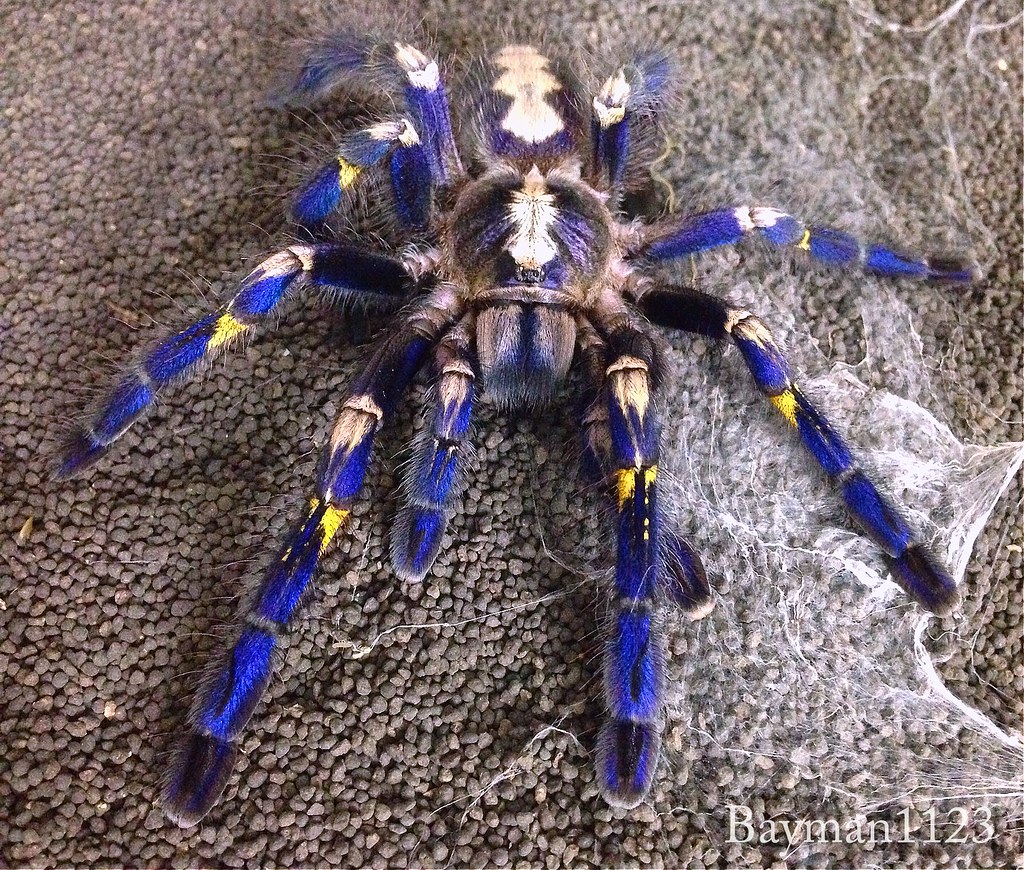
Visual Differences Between Young and Mature Peacock Tarantulas
The Gooty sapphire tarantula, also known as the peacock parachute spider, is the only blue species in the Poecilotheria genus. While young individuals have less chromatically vibrant hues, their mesmerizing blue coloration becomes more pronounced as they mature. However, in older mature males, the blue is less vivid, and they develop slender bodies with longer legs. A key distinction in mature males occurs after their “mature molt,” where their pedipalps (the pincer-like appendages near the head) swell with bulbous emboli at the tips. In contrast, females can be identified through molt confirmations before reaching maturity. When fully grown, these tarantulas boast an impressive leg span of 6 to 8 inches (about 15 to 20 centimeters), ranking them among the biggest spiders in the world.
Taxonomy and Classification
The Gooty sapphire tarantula belongs to the Old World category and is scientifically known as Poecilotheria metallica. It is often referred to by several common names, including Gooty Sapphire Ornamental, Metallic Blue Ornamental, and the Peacock Parachute Spider. This beautiful species stands out due to its vibrant blue appearance, which is rare among tarantulas. Its Old World classification means it originates from areas like India, and unlike New World tarantulas, it lacks urticating hairs but makes up for it with its defensive behaviors and striking color.
Physical Characteristics
The Gooty sapphire tarantula is an arboreal species known for its vibrant blue coloration and impressive size. Its body length reaches up to 2.5 inches (6 cm), while its diagonal leg span (DLS) can stretch to a remarkable 8 inches (20 cm). Unlike some other tarantulas, it does not possess urticating hairs. The species is known for its fast growth rate, with females living up to 12 years and males typically reaching around 4 years. This makes it a long-lived species with distinct size and features.
Habitat and Distribution
The Gooty blue tarantula is indigenous to Andhra Pradesh, a state in southeast India, which has deciduous forests. This species’ natural habitat is restricted to a tight area of around 39 square miles (100 square kilometers) within a protected forest reserve. Despite extensive surveys of adjacent forests, these blue tarantulas have not been observed outside their known range. Originally found by humans in a railway timber yard miles southwest of the reserve, it is believed that the tarantulas may have been transported via train to this location.
Geographic Range
The Poecilotheria metallica tarantula, first described by arachnologist Pocock in 1899 near the town of Gooty, India, was later rediscovered in 2001 in the Kadapah and Chittoor districts of Andhra Pradesh. This species is restricted to a small 100 sq km region, heavily impacted by human activity such as logging, land clearing, and agriculture, which threatens its survival.
Preferred Habitats
The Gooty Sapphire Tarantula is an arboreal species that prefers trees for hiding and creating webs. Its native habitat is under threat due to logging, development, and agriculture, which impact its survival. In a captive environment, this species thrives in humid conditions with temperatures between 64 to 75 degrees Fahrenheit (18 to 24°C) and a humidity level of 75 to 85 percent.
Behavior , Diet and Pet Trade
The Gooty Sapphire Tarantula is a photosensitive and fast arboreal species, typically avoiding bright lights by retreating to hides. These Old World spiders are defensive, and in the wild, they live in holes of tall trees, creating asymmetric funnel webs. Their diet predominantly consists of flying insects, which they catch with precision and agility. When threatened, the peacock tarantula tends to flee, but if cornered, it may resort to biting as a defensive mechanism. Their skittish behavior and quick movements can be both captivating and unsettling to observe.
-
Hunting Techniques:
The Gooty Sapphire Tarantula uses ambush tactics to capture prey with remarkable precision. These tarantulas remain hidden in their retreat, waiting patiently for the right moment to strike. Once they sense movement, they spring into action swiftly, ensuring a successful catch. If disturbed, they will quickly retreat to safety, demonstrating their sharp instincts and agility.
-
Dietary Habits:
The Gooty Sapphire Tarantula is a hardy species that grows fast and has a varied diet. Spiderlings are typically fed small red runner crickets, while juveniles move on to medium crickets. Adults can consume larger prey such as moths, grasshoppers, and cockroaches, with feeding sizes ranging from 4 to 14 depending on their size. More frequent feedings are required when they are molting, ensuring they stay nourished during this crucial phase.
-
Pet Trade:
The Gooty sapphire tarantula has gained significant popularity in the pet trade due to its striking blueness, making it a highly sought-after species. Over the past decade, they have been successfully bred in captivity, helping to meet the high demand for these unique tarantulas. In the U.S., the price of a Gooty sapphire tarantula can range from $100 to $200 for spiderlings, while adults can cost up to $500, making them both rare and relatively affordable compared to other exotic pets.
Reproduction and Life Cycle
-
Mating Rituals:
The mating behavior of the Gooty sapphire tarantula follows patterns that are typical of Old World tarantulas. Unlike some other species, their courtship tends to be more cautious, with the male approaching the female slowly to avoid aggressive reactions. This careful approach is a hallmark of many Old World species, which are generally known for their defensive nature during interactions.
-
Lifecycle Stages:
The spiderlings of the Gooty sapphire tarantula start off as grey and fast, quickly maturing into their iconic bright bluecoloration. Males typically live around 4 years, while females can live up to 12 years, giving them a significantly longer lifespan in comparison. As they grow, the transformation from grey to blue is a fascinating part of their development.
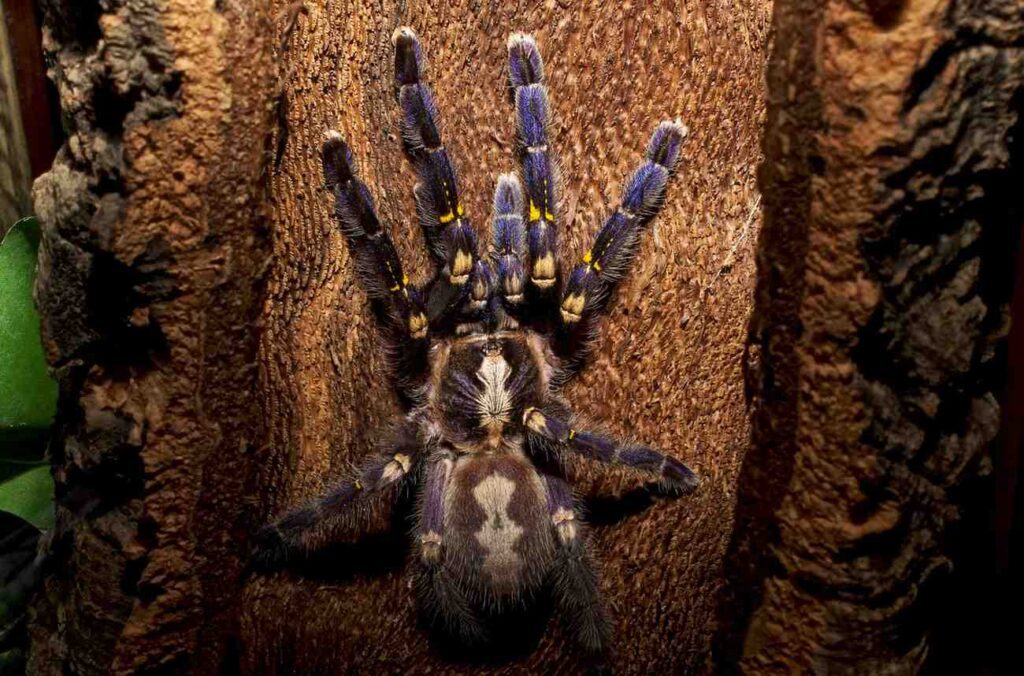
Coloration and Evolution
The striking blue coloration of the Gooty sapphire tarantula has long puzzled researchers, as most animals get their colors from pigments. However, in this species, nanocrystals in their exoskeleton reflect wavelengths of light, creating their vibrant blue appearance. This is due to the precise arrangement and alignment of these crystals, a phenomenon known as structural color, which results in an iridescent effect that can change depending on the angles of light hitting the surface. The undersides of their legs also showcase this marvelous sight, making them an impressive example of evolution. The unique blue is the subject of ongoing research, with scientists forming various hypotheses about its purpose—whether it serves for mate attraction, signal communication, or contests with other tarantulas, hinting at further evolutionary significance.
Conservation Status
The Gooty sapphire tarantula is listed as critically endangered by the International Union for Conservation of Nature (IUCN). Its home in a highly disturbed reserve forest is under constant threat due to firewood harvesting and logging. Additionally, the species is potentially vulnerable to the pet trade, where prospective owners may not know how to properly handle this delicate species. Although the exact population size is unknown, the ongoing threats to its limited habitat suggest the population is declining. Conservation efforts are crucial to protect the world’s only blue tarantula and ensure its survival in the wild.
Gooty Sapphire Tarantula FAQ
How venomous is the Gooty sapphire tarantula?
The P. metallica is known for its striking blue appearance, but its bite is what concerns many enthusiasts. Although there has never been a recorded human death from its bite, the venom is considered medically significant, causing intense pain to those who are bitten. Experienced keepers have reported that the bites from other spiders in the same genus can cause discomfort, making it important to exercise caution when handling or interacting with these fascinating creatures.
Are Gooty sapphire tarantulas good for beginners?
With adequate care and regular handling, Gooty Sapphire Tarantulas can become somewhat accustomed to humans, and may even seem quite docile. However, they are not always the best choice for beginners because they can bite if they feel threatened or are mishandled. While they can adapt to captivity, their temperament and specific care requirements make them a more challenging option for those just starting out in the world of tarantula keeping.
Can you hold a Gooty sapphire tarantula?
The Gooty sapphire tarantula, scientifically known as Poecilotheria metallica, is a beautiful yet defensive species. While their striking blue color may attract interest, they are fast and tend to be prone to running or hiding when disturbed. If they feel threatened, their behavior can escalate quickly, sometimes attacking or attempting to bite. Though their venom isn’t lethal to humans, it is still potent and can cause significant discomfort. These tarantulas are best admired from a distance, as they aren’t ideal for handling due to their unpredictable nature and speed.
Are Gooty sapphire tarantulas rare?
The Gooty sapphire tarantula, also called the peacock tarantula, is known for its vibrant blue coloration and is indeed very rare. This spider is critically endangered, mainly due to its limited habitat in a small forest area in Andhra Pradesh, India. They live in tree holes and mainly prey on flying insects. The shrinking of their natural environment has put immense pressure on their survival, making these stunning sapphire spiders difficult to find in the wild. Their striking blue makes them unique, but their habitat loss is a major concern.
How Long Do Gooty Sapphire Tarantulas Live?
The Gooty sapphire tarantula has a fascinating lifespan, especially when you consider the differences between females and males. Females can live up to 11 or 12 years, while males typically survive only 3 to 4 years. These tarantulas inhabit a small 100 km² forest reserve in central Andhra Pradesh, India, where they make their homes in the holes of tall trees. Their webs are often shaped like an asymmetric funnel, which helps them catch prey and stay hidden in the wild.Top of Form
Why is the Gooty tarantula endangered?
The Gooty sapphire tarantula is facing a critically endangered status due to several threats to its natural range. Its home is a small forest preserve, which is being exploited for its valuable resources through activities like logging. This destruction of habitat has significantly reduced the tarantula’s living space, making it vulnerable. On top of that, they are often a target for poachers because of their rare beauty, further worsening their situation. Protecting their environment is key to preventing them from disappearing.
What are the symptoms of a Gooty Sapphire bite?
A Gooty sapphire tarantula bite can cause excruciating pain due to its adult tarantula’s long fangs and venom. While this species often delivers “dry bites” (bites without venom), when venom is injected, it can lead to severe cramping, nausea, and other symptoms that may last for weeks. Although the bite won’t cause human death, the significant damage it causes can be very uncomfortable, especially with the length of the fangs, which can easily penetrate the skin.
What temperature do Gooty Sapphire tarantulas like?
Gooty Sapphire tarantulas thrive in warm environments, with room temperatures between 70-80ºF being ideal. It’s important to avoid exceeding 82ºF, as higher temperatures can stress them. A slight nighttime drop to a cooler temperature is also beneficial, though not always necessary. When keeping young Gooty Sapphire tarantulas, they are often housed in small containers like 50-dram vials or 32 oz. jars to maintain stable conditions.
